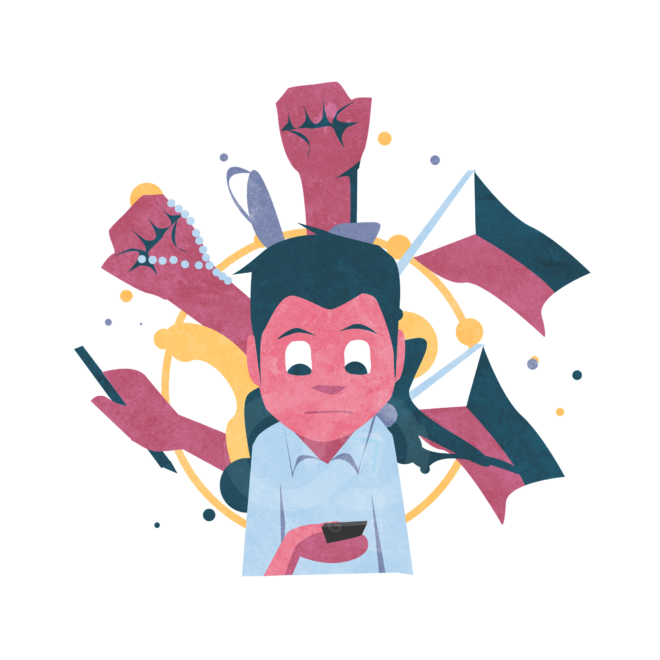Visit us on Instagram To be You; Facebook: To be You; e-mail inq.tobeyou@gmail.com

We asked young people what comes to mind when we talk about the Edsa People Power Revolution.
What does it take to win back our freedom? Are violence and mutiny the only ways to break free from the clutches of an iron hand? Or had Edsa become just another holiday?
But everyone who went to Edsa knew what they were doing. On Feb. 25, 1986, the world watched in awe as Filipinos stood their ground peacefully to put an end to the Marcos dictatorship.
Through prayers and a show of unity and courage, they reclaimed the democracy they lost during 14 years of authoritarian rule.
Edsa happened 32 years ago, long before we were born.
What can we say about it?
“The Edsa revolution reminds me of a time when Filipinos gathered peacefully against the regime of violence and dictatorship. It symbolizes hope and the power of the Filipino people to make their country a better place. It certainly is relevant as it embodies the coming together of people for the purpose of having a greater tomorrow.” —Mae, CAP College
“The Edsa revolution paved the way for the return of freedom of speech. Not all Filipinos went to Edsa, but since it was well-publicized, it looked like a spectacle rather than a model for protests nowadays. I think our generation should choose the peaceful way of protesting.” —Jamie Lin Inocencio Calica, St. Paul University Manila
“I think of freedom, of struggle and victory against a tyrant. I think it is incredibly relevant because we continue to exercise our right to demand good governance.” —Hades, Mass communication student
“Sacrifice. For me, the Edsa revolution was not a bloodless revolution. It was a revolution born out of the sacrifices of thousands of Filipinos who were tortured, who disappeared and who were killed for committing the ‘crime’ of dissent.
“Today, the Edsa revolution couldn’t be more relevant, for the freedom that Filipinos sought and fought for seems to be on the brink of being lost again.” —Topher Balagtas, Ateneo de Manila University School of Law
“There are pros and cons to the Edsa revolution. On one hand, we regained freedom and the dictatorship ended. On the other hand, people are still being discriminated upon, since only the middle and upper classes benefited from the change of government.” —Nial de Vera, San Beda Alabang
“The Edsa revolution served as an eye-opener for us. It also served as an inspiration for Filipinos to fight for their freedom. The revolution has taught us that if we help each other, we are capable of making a difference. To this day, the Edsa revolution still serves as an inspiration and a lesson to many.” —Ainjeal Gwynzler Mariano, De La Salle University
“The Edsa revolution was an epic phenomenon that demonstrated the power of the Filipino people. It was undeniable proof that the Filipinos’ desire to fight for democracy did not end with the Spanish regime. This is why it is still relevant. When we are unsure of the future of our nation’s sovereignty, learning about and appreciating this event in history is crucial to maintaining our independence.” —Cassandra Aldana, University of Santo Tomas
“The Edsa revolution’s impact was not only on the Philippines but also around the world. This remarkable event was proof that a revolution could take place in any form, including peaceful communication and unity in its highest level.” —Shannen Silvino, De La Salle Zobel
“The Edsa revolution is important because it demonstrated the efforts of Filipinos to gain the freedom they deserved. It is a democratic movement which showed the Filipinos’ courage to fight.
“This significant event has been engraved in the hearts and minds of many Filipinos. It gives us a strong sense of pride knowing that other nations have attempted to emulate what we have shown the world—the true power and essence of democracy.” —Hanej Gopez, De La Salle University
“Lots of things come to people’s minds when they hear the words ‘Edsa revolution.’ For me, it sparks an opportunity for discussion. It educates people and makes them understand our history. This gives them the chance to reflect on a particularly momentous event.” —Bethany de Sagun, Ateneo de Davao University
“The Edsa revolution highlighted the power of Filipinos to unite after the oppressive Marcos years. It was a peaceful, bloodless movement led by Catholic leaders and people from all walks of life. It is the modern symbol of freedom. Various schools use it as a representation of peaceful struggle. It depicts the rights of people to choose democracy over dictatorship the Philippines.” —Adrian Dar Serapio, Xavier School